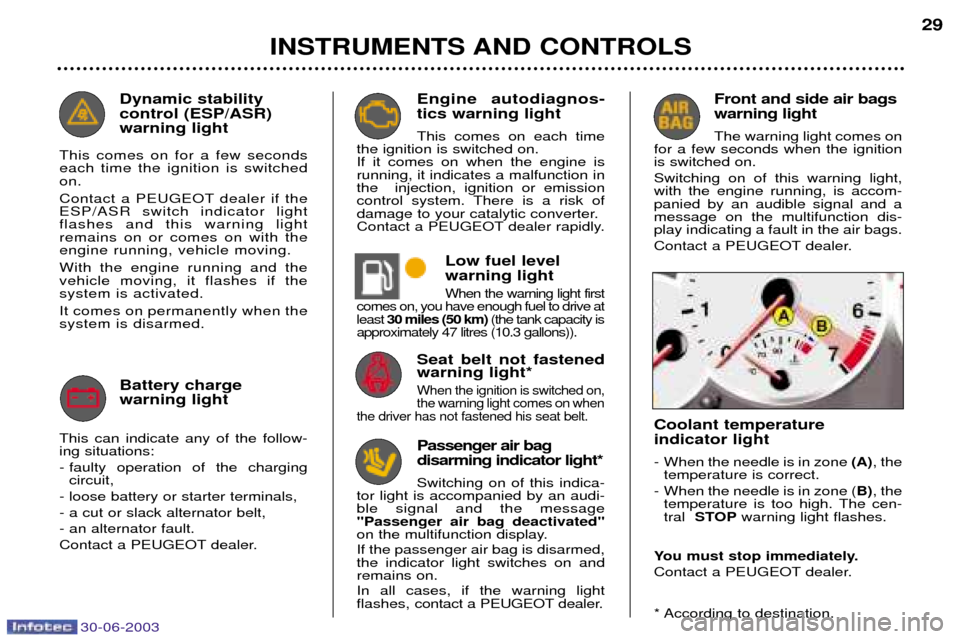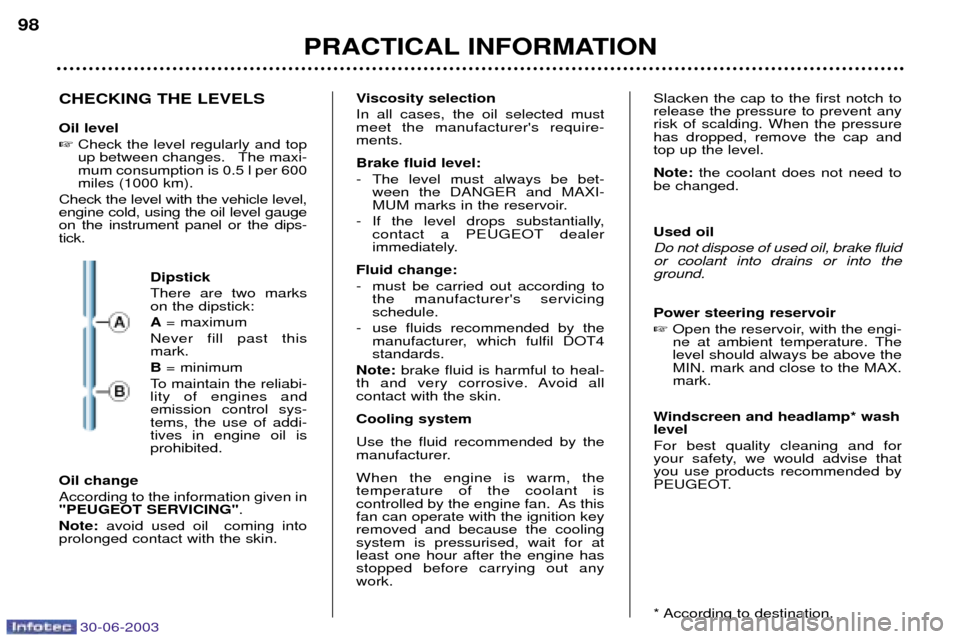Page 28 of 131

30-06-2003
INSTRUMENTS AND CONTROLS29
Front and side air bags warning light The warning light comes on
for a few seconds when the ignition is switched on. Switching on of this warning light, with the engine running, is accom-panied by an audible signal and amessage on the multifunction dis-play indicating a fault in the air bags.
Contact a PEUGEOT dealer.
Seat belt not fastened warning light*
When the ignition is switched on,the warning light comes on when
the driver has not fastened his seat belt.
Engine autodiagnos- tics warning light This comes on each time
the ignition is switched on. If it comes on when the engine isrunning, it indicates a malfunction inthe injection, ignition or emission
control system. There is a risk of
damage to your catalytic converter.
Contact a PEUGEOT dealer rapidly.
Low fuel level warning light
When the warning light first
comes on, you have enough fuel to drive at least 30 miles (50 km) (the tank capacity is
approximately 47 litres (10.3 gallons)).
Coolant temperature indicator light
- When the needle is in zone (A), the
temperature is correct.
- When the needle is in zone ( B), the
temperature is too high. The cen- tral STOP warning light flashes.
You must stop immediately.
Contact a PEUGEOT dealer.
* According to destination.
Dynamic stability control (ESP/ASR)warning light
This comes on for a few seconds each time the ignition is switchedon.
Contact a PEUGEOT dealer if the ESP/ASR switch indicator lightflashes and this warning lightremains on or comes on with theengine running, vehicle moving. With the engine running and the vehicle moving, it flashes if thesystem is activated. It comes on permanently when the system is disarmed.
Passenger air bag disarming indicator light* Switching on of this indica-
tor light is accompanied by an audi- ble signal and the message''Passenger air bag deactivated''
on the multifunction display. If the passenger air bag is disarmed, the indicator light switches on andremains on. In all cases, if the warning light flashes, contact a PEUGEOT dealer.
Battery charge warning light
This can indicate any of the follow- ing situations:
- faulty operation of the charging circuit,
- loose battery or starter terminals,- a cut or slack alternator belt,- an alternator fault.
Contact a PEUGEOT dealer.
Page 99 of 131
30-06-2003
PRACTICAL INFORMATION
96
1 -
Power steering reservoir
2 - Windscreen and headlamp* wash reservoir
3 - Coolant reservoir 4 -
Brake fluid reservoir
5 - Battery
6 - Air filter 7 -
Dipstick
8 - Engine oil filler cap
* According to destination.
1.6 litre 16V ENGINE
Page 100 of 131
30-06-2003
PRACTICAL INFORMATION97
1 -
Power steering reservoir
2 - Windscreen and headlamp* wash reservoir
3 - Coolant reservoir 4 -
Brake fluid reservoir
5 - Battery
6 - Air filter 7 -
Dipstick
8 - Engine oil filler cap
* According to destination.
2 litre 16V engine
Page 101 of 131

30-06-2003
PRACTICAL INFORMATION
98
CHECKING THE LEVELS Oil level �
Check the level regularly and top
up between changes. The maxi-mum consumption is 0.5 l per 600miles (1000 km).
Check the level with the vehicle level,engine cold, using the oil level gaugeon the instrument panel or the dips-tick.
Dipstick There are two marks on the dipstick: A= maximum
Never fill past this mark. B = minimum
To maintain the reliabi- lity of engines andemission control sys-tems, the use of addi-tives in engine oil isprohibited.
Oil change According to the information given in
"PEUGEOT SERVICING" .
Note: avoid used oil coming into
prolonged contact with the skin. Viscosity selection In all cases, the oil selected must meet the manufacturer's require-ments. Brake fluid level:
- The level must always be bet-
ween the DANGER and MAXI-
MUM marks in the reservoir.
- If the level drops substantially, contact a PEUGEOT dealer
immediately.
Fluid change:
- must be carried out according to the manufacturer's servicing schedule.
- use fluids recommended by the manufacturer, which fulfil DOT4standards.
Note: brake fluid is harmful to heal-
th and very corrosive. Avoid allcontact with the skin. Cooling systemUse the fluid recommended by the
manufacturer. When the engine is warm, the temperature of the coolant is
controlled by the engine fan. As thisfan can operate with the ignition keyremoved and because the coolingsystem is pressurised, wait for atleast one hour after the engine hasstopped before carrying out anywork. Slacken the cap to the first notch torelease the pressure to prevent anyrisk of scalding. When the pressurehas dropped, remove the cap andtop up the level. Note:
the coolant does not need to
be changed. Used oil Do not dispose of used oil, brake fluid or coolant into drains or into theground. Power steering reservoir � Open the reservoir, with the engi-
ne at ambient temperature. Thelevel should always be above theMIN. mark and close to the MAX.mark.
Windscreen and headlamp* washlevel For best quality cleaning and for
your safety, we would advise thatyou use products recommended by
PEUGEOT.
* According to destination.
Page 113 of 131
30-06-2003
PRACTICAL INFORMATION109
Fuse Rating
Functions
1 15 A Heated seat - Alarm
4 20 A Mulltifunction screen - Navigation control unit - Boot lighting - Audio system - Retractable roof control unit
5 15 A Automatic gearbox diagnostics
6 10 A Coolant level - Automatic gearbox - Audio system - Steering wheel angle sensor (ESP)
7 15 A Driving school accessories - Alarm fitted as an accessory - Rain detector
9 30 A Hydraulic pump
10 40 A Driving mirror demisting 11 15 A Windscreen wiper
12 30 A Front windows
14 10 A Engine module - Air bags - Steering wheel stalk
15 15 A Instrument panel - Multifunction screen - Navigation control unit - Air conditioning - Audio system
16 30 A Locking/unlocking of doors
20 10 A Right-hand brake light
21 15 A Left-hand brake light - 3rd brake light
22 20 A Front courtesy light - Glove box lighting - Lighter
S1 Shunt PARC shunt
Page 119 of 131

30-06-2003
PRACTICAL INFORMATION115
TOWING A TRAILER,
CARAVAN, BOAT etc.
Only use original PEUGEOT tow bars that have been tested andapproved from the design stage of
your vehicle. The tow bar must be
fitted by a PEUGEOT dealer.
Your vehicle is primarily designed for transporting people and luggagebut it may also be used for towing a
trailer. Driving with a trailer subjects the towing vehicle to more significantstress and its driver must beparticularly careful. Air density decreases with altitude, thus reducing engine performance.Above 1000 metres, the maximumtowing load must be reduced by 10% and so on for every 1000 metres of altitude.Driving advice Distribution of loads :
Distribute
the load in the trailer so that the heaviest items are as close as pos-sible to the axle and the nose weightapproaches the maximum permittedwithout exceeding it. Cooling :
Towing a trailer on a slope increases the temperature of the coolant. As the fan is electrically controlled, its cooling capacity is not dependenton the engine speed.
On the contrary, use a high gear to lower the engine speed and reduceyour speed. The maximum towing load on a long slope depends on the gradient andthe outside temperature. In all cases, pay attention to the coolant temperature. If the warning light comes on, stop
the vehicle and switch off the engineas soon as possible. Tyres : Check the tyre pressures of the tow-
ing vehicle and of the trailer, observ-ing the recommended pressures. Braking :
Towing increases the braking distance. Lights : Check the electrical signalling on the
trailer. Side wind :
Take into acount the increased sensitivity to side wind.